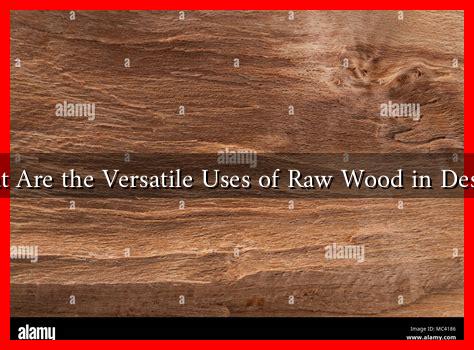-
Table of Contents
What Are the Versatile Uses of Raw Wood in Design?
Raw wood has long been a staple in design, celebrated for its natural beauty, durability, and versatility. From furniture to architectural elements, the applications of raw wood are vast and varied. This article explores the multifaceted uses of raw wood in design, highlighting its aesthetic appeal, sustainability, and functional benefits.
The Aesthetic Appeal of Raw Wood
One of the primary reasons designers gravitate towards raw wood is its inherent beauty. The unique grain patterns, textures, and colors of different wood species can enhance the visual appeal of any space. Here are some ways raw wood contributes to aesthetics:
- Natural Warmth: Raw wood adds warmth to interiors, creating a cozy and inviting atmosphere.
- Unique Character: Each piece of wood has its own story, with knots, grains, and imperfections that add character.
- Versatile Finishes: Raw wood can be left unfinished for a rustic look or treated with stains and finishes to match various design styles.
For instance, the use of reclaimed wood in modern homes not only provides a rustic charm but also tells a story of sustainability and history. Designers like Joanna Gaines have popularized the use of raw wood in their projects, showcasing its ability to blend seamlessly with contemporary aesthetics.
Functional Uses of Raw Wood in Design
Beyond its beauty, raw wood serves numerous functional purposes in design. Its strength and versatility make it an ideal material for various applications:
- Furniture: Tables, chairs, and shelving units made from raw wood are not only sturdy but also timeless.
- Architectural Elements: Beams, columns, and paneling can enhance structural integrity while adding visual interest.
- Decorative Accents: Items like wooden bowls, wall art, and sculptures can serve as focal points in a room.
For example, the Scandinavian design movement emphasizes simplicity and functionality, often incorporating raw wood in furniture and decor. Brands like Muji and IKEA have successfully integrated raw wood into their product lines, appealing to consumers seeking minimalist yet functional designs.
Sustainability and Environmental Impact
In an era where sustainability is paramount, raw wood stands out as an eco-friendly material. Here are some reasons why raw wood is considered a sustainable choice:
- Renewable Resource: Wood is a renewable resource when sourced responsibly from sustainably managed forests.
- Carbon Sequestration: Trees absorb carbon dioxide, helping to mitigate climate change.
- Biodegradable: Unlike synthetic materials, wood is biodegradable and can be composted at the end of its life cycle.
According to the Forest Stewardship Council (FSC), sustainably sourced wood can significantly reduce the environmental impact of construction and design. By choosing FSC-certified wood, designers can ensure that their materials come from responsibly managed forests.
Case Studies: Successful Applications of Raw Wood
Several notable projects have successfully utilized raw wood in innovative ways:
- The High Line, New York City: This elevated park features raw wood decking and seating, blending nature with urban design.
- Apple Park, Cupertino: The headquarters incorporates extensive use of raw wood in its interiors, promoting a connection to nature.
- Treehotel, Sweden: This unique hotel features treehouses made from raw wood, offering guests a sustainable and immersive experience in nature.
These examples illustrate how raw wood can be integrated into various design contexts, enhancing both functionality and aesthetics.
Conclusion
Raw wood is a versatile material that offers a plethora of uses in design, from furniture to architectural elements. Its aesthetic appeal, functional benefits, and sustainability make it a favored choice among designers and consumers alike. As the demand for eco-friendly materials continues to rise, raw wood stands out as a timeless option that not only enhances the beauty of spaces but also contributes positively to the environment. By embracing the versatile uses of raw wood, designers can create spaces that are not only visually stunning but also sustainable and functional.
For more insights on sustainable design practices, consider visiting FSC’s official website.

